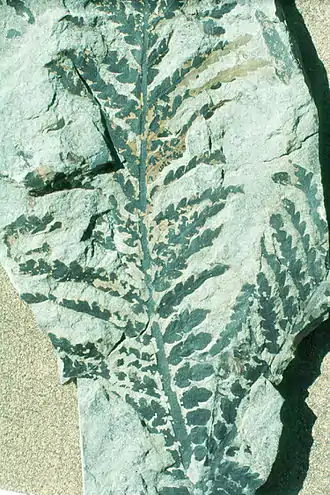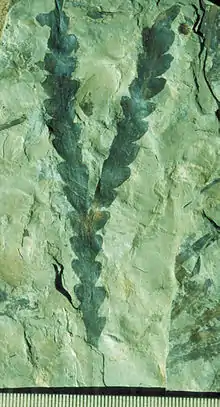Dicroidium
Dicroidium is an extinct genus of fork-leaved seed ferns that were widely distributed over Gondwana during the Triassic (252 to 201 million years ago). Their fossils are known from South Africa, the Arabian Peninsula, Australia, New Zealand, South America, Madagascar, the Indian subcontinent and Antarctica. They were first discovered in Triassic sediments of Tasmania by Morris in 1845.[4] Fossils from the Umm Irna Formation in Jordan and in Pakistan indicate that these plants already existed in Late Permian.[5][6] Late surviving members of the genus are known from the Early Jurassic (Sinemurian) of East Antarctica.[7]

| Dicroidium | |
|---|---|
 | |
| Dicroidium odontopteroides fossil leaf, Late Triassic Molteno Formation near Birds River South Africa. | |
| Scientific classification | |
| Kingdom: | Plantae |
| Clade: | Tracheophytes |
| Division: | †Pteridospermatophyta |
| Order: | †Peltaspermales |
| Family: | †Corystospermaceae |
| Genus: | †Dicroidium Gothan (1912) |
| Species | |
| |
Description
The leaves are similar to those of modern ferns but like all seed ferns (Pteridospermatophyta) were thick and had substantial cuticles. Dicroidium differs from other seed fern leaves in having a forked rachis; giving the appearance of two fern leaves joined at the base. These plants had male and female reproductive structures. Following the form generic nomenclature of paleobotany, male pollen-bearing structures are separately named Pteruchus and the female structures Umkomasia.[8]
Whole plant reconstructions
Different organs attributed to the same original plant can be reconstructed from co-occurrence at the same locality and from similarities in the stomatal apparatus and other anatomical peculiarities of fossilized cuticles.
- Dicroidium odontopteroides may have been produced by the same plant as Umkomasia macleanii (ovulate structures) and Pteruchus africanus (pollen organs).[9]
- Dicroidium zuberi may have been produced by the same plant as Umkomasia feistmantelii (ovulate structures) and Pteruchus barrealensis (pollen organs)[10]
References
- THE TRIASSIC TAPHOFLORA FROM PARANA BASIN, SOUTHERN BRAZIL
- Retallack G.J. (1985). "Triassic fossil plant fragments from marine rocks of the Murihiku Supergroup, New Zealand". Journal of the Royal Society of New Zealand. 15: 1–26. doi:10.1080/03036758.1985.10421741.
- Passo das Tropas, Santa Maria, RS Marco bioestratigráfico triássico na evolução paleoflorística do Gondwana na Bacia do Paraná.
- Strzelecki, P.E. (1845). Physical descriptions of New South Wales and van Diemens Land. Brown, Green and Longmans, London. pp. 422 pp.
- Patrick Blomenkemper; Hans Kerp; Abdalla Abu Hamad; William A. DiMichele; Benjamin Bomfleur (2018). "A hidden cradle of plant evolution in Permian tropical lowlands". Science. 362 (6421): 1414–1416. Bibcode:2018Sci...362.1414B. doi:10.1126/science.aau4061. PMID 30573628.
- Schneebeli-Hermann, Elke; Kürschner, Wolfram M.; Kerp, Hans; Bomfleur, Benjamin; Hochuli, Peter A.; Bucher, Hugo; Ware, David; Roohi, Ghazala (April 2015). "Vegetation history across the Permian–Triassic boundary in Pakistan (Amb section, Salt Range)". Gondwana Research. 27 (3): 911–924. Bibcode:2015GondR..27..911S. doi:10.1016/j.gr.2013.11.007.
- Bomfleur, Benjamin; Blomenkemper, Patrick; Kerp, Hans; McLoughlin, Stephen (2018), "Polar Regions of the Mesozoic–Paleogene Greenhouse World as Refugia for Relict Plant Groups", Transformative Paleobotany, Elsevier, pp. 593–611, doi:10.1016/b978-0-12-813012-4.00024-3, ISBN 978-0-12-813012-4, retrieved 2020-11-12
- http://www.fossilmuseum.net/plantfossils/Umkomasia/Umkomasia.htm
- Retallack, G.J.; Dilcher, D.L. (1988). "Reconstructions of selected seed ferns". Missouri Botanical Garden Annals. 75 (3): 1010–1057. doi:10.2307/2399379. JSTOR 2399379.
- Retallack G.J. (1977). "Reconstructing Triassic vegetation of southeastern Australia: a new approach to the biostratigraphy of Gondwanaland". Alcheringa. 1: 247–265. doi:10.1080/03115517708527763.
- Bomfleur, B. and Kerp, H. (2010). Dicroidium diversity in the Upper Triassic of north Victoria Land, East Antarctica.
